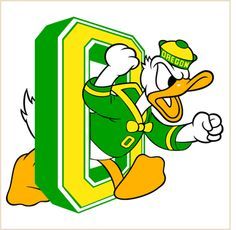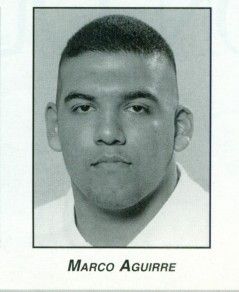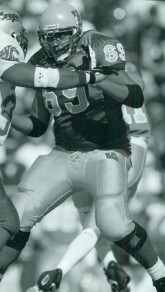Marco Aguirre and the O-Line
The great subtext behind the quarterback battle getting all the press remained whom exactly would block for them, and returning starting runningback Saladin McCullough. Marco Aguirre came aboard with expectations of filling a role immediately a junior college transfer from Mount San Antonio College, in Walnut, California.
“I arrived in the winter term (January, 1997) to get established,” Aguirre recalls. “After the Christmas break, I came up, but I guess it was a day too early because when I got there, they were still closed and no one was there. I had to sleep in my car the first night, because there was no one at the dorm and they couldn’t let me in.”
For Aguirre, the prospect of getting a legitimate shot to play immediately was too enticing to pass up compared the other schools courting the talented lineman. “The only other schools I was looking at were UCLA and Washington State. I toured Wisconsin, but it was small compared to everyone else; it wasn’t the right school for me. UCLA, I didn’t feel the line coach was on the same page. Washington State was too far in the middle of nowhere. Eugene was real nice. It was nice knowing I would play and be a starter, and to find the same offense I was used to helped to understand and get everything quickly.”
Aguirre didn’t have to wait long to see the field, coming straight from the JC ranks into a starting role that he would retain for the next two seasons.
“I had an advantage being there for winter term. I had played in the spring game and got established. There were a lot of new kids that had to come in for fall camp and during September during the fall; but I was already there. Since January, I had worked to learn everything, train, and be prepared for fall camp. Also, Mount San Antonio ran a very similar offense I was already acclimated to. I had an advantage on that end.”
Given the lack of experience in the remaining offensive linemen in Oregon’s system, the lone veteran on the squad was relied on heavily to relay information to the newcomers.
“The main guy that year was (David) Weber. He was the one who taught everyone, because he was the only starter from the year before. He and (previous backup) Seaton Daly were the seniors of that year. They had been around and seen all, I was the new one. If you had any questions, you just asked Weber, because he was the smartest one there and knew the most. Daly was the one who took over after Weber got injured. It was fun; but also hard. We were all learning at the same time, especially me coming in.”
Weber’s lessons paid off well, as Oregon’s offensive line played admirably with their patchwork lineup. 1997 would prove to be a year of experimentation, treated almost like a precursor to the success of the 1998 season. The Ducks rotated both Maas and Smith at quarterback extensively, awaiting for one to emerge. By the end of the year, that was Akili Smith, ready to take the reigns in 1998, setting nearly every single-season passing record at Oregon and earning his status as the third overall draft pick in the 1999 NFL draft.
The experimentation continued along the offensive line, using plug-and-play linemen such as Aguirre to gain experience for what became a potent offense in 1998, for the first half of the year the #1 offense in the country averaging 50 points a game. Damon Griffin, who could have returned halfway through the 1997 season from his thumb injury, instead chose to redshirt the season to return for his senior year knowing that the 1998 would be special–Griffin became a 1st team All-Pac-10 selection the next year. The uncertainty of 1997 gave way to the excellence of 1998, Oregon appearing to be unstoppable, until injuries would derail the efforts, forever leaving fans to wonder how good the 1998 team had been if key players had not been struck down mid-season.
Aguirre recalls the ongoing experimentation with lineups to find what worked best. “It was a rough start. We weren’t fully prepared by game time. When I think back to the Arizona game to open the season, it was rough. I think against Nevada (in the second game) that one really helped us out a lot. That was a real turning point of that year. It was really close. It was a pretty tough game. On one drive, we started out at the one yard-line, and had a 99 yard drive. It was pretty tough, but I think that game helped us out and started the come-together process.”
The Ducks would finish 1997 at 6-5, swapping Maas and Smith between drives and mixing-and-matching lineman in a season-long trial and error process to see what might work. BY the end of the year they had it down, and knew that through the year-long process they were going to have a special team returning the next year. Oregon would dominate Air Force in the Las Vegas Bowl, scoring long touchdowns on the first two plays from scrimmage on their way to a 41-13 victory.
The lessons to be learned from the past can be used to foresee the future. Oregon has been a great team the past few years, and with the returning talent they can potentially be great again.
However with expectations sky high for this team, some reality needs to be maintained, that with Oregon having to replace statistically the greatest running back and quarterback tandem in school history with talented but inexperienced players, there is the potential for a repeat of a 1997-style season–A year where players are mixed-and-matched, various lineups are tested to see what works, quarterbacks are rotated each given an opportunity to see who can best lead, and the final results immediately may not be completely to Oregon fan’s liking, but has the potential to pay even bigger dividends down the road.
By the end of the season, Oregon’s offensive line was opening up huge gaps












